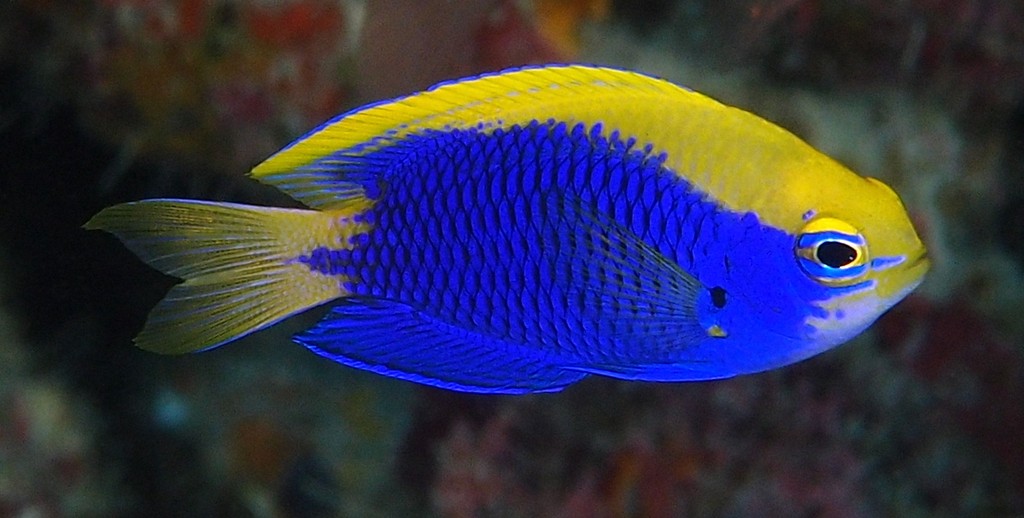CHRYSIPTERA STARCKI - (ALLEN, 1973)
Actinopterygii (Gigaclass) > Actinopteri (Class) > Teleostei (Subclass) > Blenniiformes (Order) > Pomacentridae (Family) > Pomacentrinae (Subfamily) > Chrysiptera (Genus)
Demoiselle de Starck, Starck's damsel, Starck's demoiselle, Senaki-ruri-suzumedai, セナキルリスズメダイ, 史氏刻齒雀鯛, 史氏金翅雀鯛,
Synonymes
Abudefduf starcki (Allen, 1973)
Chrysiptera starki (Allen, 1973)
Chryspetera starcki (Allen, 1973)
Glyphidodontops starcki (Allen, 1973)
-----------------------
Description
Dorsal spines (total): 13; Dorsal soft rays (total): 14-15; Anal spines: 2; Anal soft rays: 15-17; Pectoral fin rays: 15-17; Lateral line scales: 15-17; Gill rakers: 21-22; Body depth: 2.2-2.5 in Standard length. Max length: 7.0 cm SL. Depth range: 20 - 60 m.
Color
Blue with a wide yellow band along their back. The lower part of the jaw is yellow and there are lines on their cheeks. The fins differentiate in color: the dorsal and caudal are yellow; the anal and pelvic are blue. There are yellowish dashes on the pectoral fins and a small black spot.
Etymology
Chrysiptera: from Greek, chrysos = golden + from Greek, pteron = fin, wing. Referring to yellow caudal fin and/or yellowish pectoral and ventral fins of Glyphisodon azureus Cuvier, 1830 (= Chrysiptera cyanea (Quoy & Gaimard, 1825)).
starcki: named starcki in honour of Dr. Walter A. Starck II, who first pointed out the species to me while diving at Osprey Reef. The species is also named in honor of Dr Starck, whose collecting efforts, photos, and observations added much to our knowledge.
Original description : Abudefduf starcki Allen, 1973 - Type locality: collected with multi-prong spear on outer slope of Osprey Reef, Coral Sea (13°58'S, 146°41'E; U.S.H.O. Chart No. 2002) in 37 metres by G. R. Allen on June 22, 1972.
Distribution
Western Pacific: Western Coral Sea (Australia), New Caledonia, Loyalty Islands, Fiji; Taiwan north to Japan.
Biology
Adults inhabit rocky outcrops and crevices that are frequently situated in sand channels on outer reef slopes.
Their diet consists of plankton and algae. Oviparous, distinct pairing during breeding. Eggs are demersal and adhere to the substrate. Males guard and aerate the eggs. This is a highly desired fish for a saltwater aquarium.
Similar species
Chrysiptera bleekeri (Fowler & Bean, 1928) - Reported from Eastern Indoan Ocean, western Pacific: Flores and West Timor (Indonesia) east to Philippines.
Chrysiptera flavipinnis (Allen & Robertson, 1974) - Reported from Southwestern Pacific: eastern Papua New Guinea, eastern Australia south to southern New South Wales, Solomon Islands and western Coral Sea (Chesterfield Islands (New Caledonia)).
Last update: 22, April 2022
Demoiselle de Starck, Starck's damsel, Starck's demoiselle, Senaki-ruri-suzumedai, セナキルリスズメダイ, 史氏刻齒雀鯛, 史氏金翅雀鯛,
Synonymes
Abudefduf starcki (Allen, 1973)
Chrysiptera starki (Allen, 1973)
Chryspetera starcki (Allen, 1973)
Glyphidodontops starcki (Allen, 1973)
-----------------------
Description
Dorsal spines (total): 13; Dorsal soft rays (total): 14-15; Anal spines: 2; Anal soft rays: 15-17; Pectoral fin rays: 15-17; Lateral line scales: 15-17; Gill rakers: 21-22; Body depth: 2.2-2.5 in Standard length. Max length: 7.0 cm SL. Depth range: 20 - 60 m.
Color
Blue with a wide yellow band along their back. The lower part of the jaw is yellow and there are lines on their cheeks. The fins differentiate in color: the dorsal and caudal are yellow; the anal and pelvic are blue. There are yellowish dashes on the pectoral fins and a small black spot.
Etymology
Chrysiptera: from Greek, chrysos = golden + from Greek, pteron = fin, wing. Referring to yellow caudal fin and/or yellowish pectoral and ventral fins of Glyphisodon azureus Cuvier, 1830 (= Chrysiptera cyanea (Quoy & Gaimard, 1825)).
starcki: named starcki in honour of Dr. Walter A. Starck II, who first pointed out the species to me while diving at Osprey Reef. The species is also named in honor of Dr Starck, whose collecting efforts, photos, and observations added much to our knowledge.
Original description : Abudefduf starcki Allen, 1973 - Type locality: collected with multi-prong spear on outer slope of Osprey Reef, Coral Sea (13°58'S, 146°41'E; U.S.H.O. Chart No. 2002) in 37 metres by G. R. Allen on June 22, 1972.
Distribution
Western Pacific: Western Coral Sea (Australia), New Caledonia, Loyalty Islands, Fiji; Taiwan north to Japan.
Biology
Adults inhabit rocky outcrops and crevices that are frequently situated in sand channels on outer reef slopes.
Their diet consists of plankton and algae. Oviparous, distinct pairing during breeding. Eggs are demersal and adhere to the substrate. Males guard and aerate the eggs. This is a highly desired fish for a saltwater aquarium.
Similar species
Chrysiptera bleekeri (Fowler & Bean, 1928) - Reported from Eastern Indoan Ocean, western Pacific: Flores and West Timor (Indonesia) east to Philippines.
Chrysiptera flavipinnis (Allen & Robertson, 1974) - Reported from Southwestern Pacific: eastern Papua New Guinea, eastern Australia south to southern New South Wales, Solomon Islands and western Coral Sea (Chesterfield Islands (New Caledonia)).
Last update: 22, April 2022
